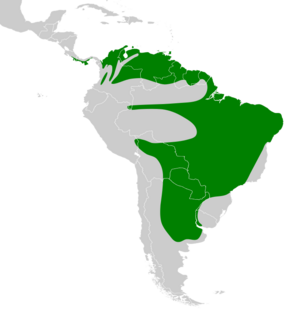Pale-breasted spinetail facts for kids
Quick facts for kids Pale-breasted spinetail |
|
|---|---|
 |
|
| At Piraju, São Paulo State, Brazil | |
| Conservation status | |
| Scientific classification | |
| Genus: |
Synallaxis
|
| Species: |
albescens
|
 |
|
The pale-breasted spinetail (Synallaxis albescens) is a small songbird. It belongs to the ovenbird family called Furnariidae. You can find this bird in many places. It lives in Costa Rica, Panama, Trinidad, and most countries in South America. The only mainland South American countries where it is not found are Chile and Ecuador.
Contents
Understanding the Pale-breasted Spinetail
How Scientists Classify This Bird
Scientists group living things into categories. This is called taxonomy. The pale-breasted spinetail is a bird that has many different types, called subspecies. Currently, the International Ornithological Committee (IOC) recognizes 11 subspecies.
Sometimes, scientists have different ideas about how to group these birds. For example, the Clements taxonomy lists two more subspecies. Also, another bird, the dark-breasted spinetail, was once thought to be the same species. Now, many scientists see them as very close relatives. For this article, we will follow the IOC's view of 11 subspecies.
What Does the Pale-breasted Spinetail Look Like?
The pale-breasted spinetail is a small bird. It is about 13 to 16 centimeters (5 to 6 inches) long. It weighs between 9 and 17 grams (0.3 to 0.6 ounces). Both male and female birds look the same.
The main type of pale-breasted spinetail has a pale brownish-gray face. It has a lighter line that goes through its eye. Its forehead is olive-grayish brown. The top of its head, called the crown, is a dark reddish-brown. Its back and tail feathers are olive-brown. The feathers on its wings are reddish-brown.
Its throat is whitish with some black spots. Its chest is a pale, creamy gray. The belly is even lighter. Its eyes can be yellowish or light brown. Its beak is dark gray or black. Its legs and feet are yellowish-brown or grayish-olive. Young birds look a bit different. They have a brownish-gray crown and lighter colors overall.
How Subspecies Differ
The other 10 subspecies of the pale-breasted spinetail have small differences in their colors. Some might be darker or lighter. Some might have more gray or more brown feathers. For example, one subspecies, S. a. latitabunda, is darker than the main type. Another, S. a. perpallida, has a very white belly. These small changes help them blend into their different environments.
Where Does the Pale-breasted Spinetail Live?
This bird lives in many different places across Central and South America. For example, one subspecies, S. a. latitabunda, lives in Costa Rica and parts of Panama and Colombia. Another, S. a. albescens, is found in eastern and southern Brazil, Paraguay, and Argentina.
The pale-breasted spinetail likes open, grassy areas. You can find it in savannas, shrublands, and brushy woodlands. It also lives in pastures, near the edges of forests, and along roadsides. It usually lives in areas below 1,500 meters (about 4,900 feet) in elevation. In some places, like Colombia, it can be found up to 1,800 meters (about 5,900 feet) high.
Pale-breasted Spinetail Behavior
Movement and Migration
Most pale-breasted spinetails stay in the same area all year long. They are considered residents. However, some birds in the southernmost parts of their range might move north a little bit after their breeding season.
What Do They Eat?
The pale-breasted spinetail eats many kinds of small creatures. Its diet mainly includes arthropods, which are insects and spiders. It also eats small snails. These birds usually hunt for food in pairs. They pick their prey from grass, leaves, small branches, and sometimes the ground. They usually stay close to the ground, typically below 2 meters (about 6.5 feet).
Reproduction and Life Cycle
The breeding season for the pale-breasted spinetail changes depending on where they live. It usually happens during the local spring and summer. Even though they are called "ovenbirds," they don't make nests out of clay like some other birds in their family.
Instead, they build a round nest from grass and thorny sticks. The nest has a tunnel-like entrance. Inside, the nest is lined with soft plant material. They usually place their nests in tall grass or a bushy plant. The nest is often within 2 meters (about 6.5 feet) of the ground. Sometimes, they build them as high as 9 meters (about 30 feet).
A female pale-breasted spinetail lays two to four eggs. The eggs hatch after about 15 to 18 days. The young birds leave the nest about 16 days after they hatch. Both parents help to incubate the eggs and care for the baby birds.
What Do They Sound Like?
The pale-breasted spinetail sings for long periods. Its song has been described in different ways. Some say it sounds like a "sharp, scratchy zwee-bit, zweebit." Others describe it as a "very high scratchy wéetjirr wéetjirr" or an "unceasing, very high, shrill 'zutsweet zutsweet- -' ".
They also have different calls. In Costa Rica, their call is a "sharp 'bip'" that is often repeated. It can be followed by a "long rattling 'churrr'". In Brazil, their call is described as an "extr. high 'tsweét'".
Status of the Pale-breasted Spinetail
The IUCN (International Union for Conservation of Nature) has evaluated the pale-breasted spinetail. They have listed it as a species of "Least Concern." This means it is not currently in danger of extinction.
The bird lives across a very large area. Scientists estimate there are about 50 million adult birds. This population is believed to be stable, meaning it's not decreasing. No major threats have been found for this species. It is quite common in most places where it lives. It can even handle some human changes to its habitat, as long as there is still enough tall grass. In fact, it is expanding its range in some areas where land has been cleared.


